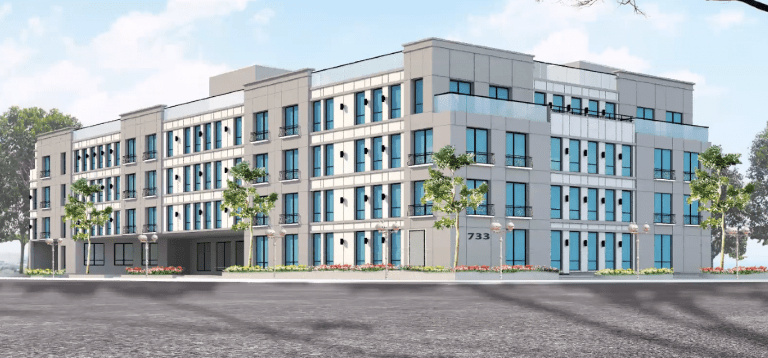
Plans for a four-story mixed-use apartment complex at 733-41 Middle Neck Road in Great Neck were once again removed from the Nassau County Industrial Development Agency’s agenda on Thursday.
The IDA’s agenda for Thursday night’s meeting listed the project, developed by Gesher Center LLC, as subject for an approval resolution for its plans and proposed tax breaks, but Chairman Richard Kessel said the applicant requested the matter be tabled again, after it initially was in March.
Kessel previously said more conversations were needed between the developer and the public to address concerns about the project. He said last week he hopes the project will be discussed at a future meeting.
The project is a proposed four-story, mixed-use building that would stand 44 feet high and contain 60 homes – including 56 two-bedroom apartments and four one-bedroom apartments – along with 93 below-grade parking spaces, a recreation center and a public art gallery. Five buildings riddled with chipped and faded paint currently occupy the space that the plans encompass.
In December 2019, the project started out as a 25-unit complex with 12 incentives later granted by the Village of Great Neck Board of Trustees in February 2020.
Village officials later said that the original proposal was withdrawn by the developer, and plans for the 60-unit complex were taken directly to the village’s Board of Zoning Appeals later that year.
With the expansion of the proposal, the project overlapped with the village’s Residence C and Residence E, or apartment, zones.
According to Village of Great Neck Mayor Pedram Bral, the project was resubmitted to the zoning board rather than the Board of Trustees due to the zoning approvals that the Board of Trustees could not grant the developer.
“Changing zones is not within the scope of the Board of Trustees and only the Zoning Board of Appeals is able to make those changes,” Bral said in a September interview with Blank Slate Media.
Because the plans were changed, the incentives initially granted by the Board of Trustees became null and void, Bral said.
In March 2021, the village’s Board of Zoning Appeals unanimously approved the site plan for the updated proposal, which also included a meeting room, two recreation rooms and a storage unit on the sub-level floors.
The Board of Trustees approved updated architectural and facade plans for the proposed complex in May. Updates featured French balconies, a more compartmentalized appearance and ornamental lighting on the building’s exterior.
Residents expressed their concerns about the proposed structure to IDA officials during a September meeting at Village Hall. Some spoke about their displeasure with the project and advocated that the developer not be granted any tax breaks in the form of payments in lieu of taxes, also known as PILOT relief.
“Simply put, we cannot afford to further excuse developers from contributing to that which makes any town viable and attractive,” village resident Karen Bardash said. “We need to have money coming in, we need money in the way of taxes. If builders cannot afford to build without incentives, they should not build.”
A week after the meeting at Village Hall, the IDA board addressed the proposal and the various resolutions packaged with it during a public board meeting. The resolutions included a 22-year tax break package, approval for the project under state environmental law and an overall approving resolution.
More information surrounding the tax breaks was not immediately available.
John Farrell, a lawyer for the project’s developer, Gesher Center LLC, said he and the developer were aware of the residents’ concerns but added that the project was something that the village wanted to incorporate into its community during the board’s Sept. 21 meeting.
“I’m familiar with the residents’ comments and concerns,” said Farrell, who works with the law firm of Sahn, Ward, Braff, Koblenz PLLC. “This is something that the village wants. We would not be here right now if the village wasn’t supportive of this project.”
Before the agenda was updated without the discussion of the project on it, Village of Great Neck resident Rebecca Rosenblatt Gilliar sent a letter to members of the agency board urging them to reconsider their draft approvals and if the project is deemed to be worthy of PILOTs.
“It is not a matter of whether someone is a senior citizen or a breadwinner for a young family,” Gilliar said. “None of us can afford to pay for the mayor’s profligacy with non-profit status, and therefore none of us can afford for you, the IDA, to assign us yet another piece of the tax burden were you to grant a carpetbagger tax relief and foist it on us, the homeowners.”
Carrie-Anne Tondo of Ingerman Smith LLP, representing the Great Neck school district, spoke during the Sept. 21 meeting about the lack of concrete information from the developer on how schools would be affected by the building.
“The payments to the district from the applicant are significantly less than if that property were put onto the tax roll as an approved project,” Tondo said. “Additional analysis concerning costs for projected school-age children was also absent in any of the documents that were submitted.”
Farrell told the IDA board that the project does not anticipate more than seven children living in the building. Tondo said that if the building had 10 school-age children, the annual PILOT payments would not cover the cost of those students until 14 years into the PILOT relief the developer seeks.






